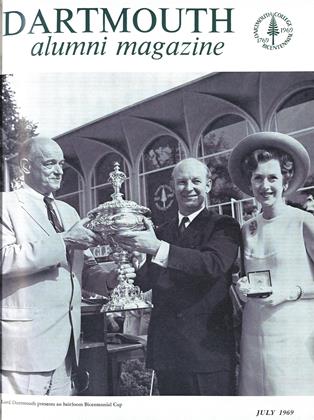PARKER ON THE IROQUOIS. IROQUOIS USES OF MAIZE AND OTHER FOOD PLANTS. THE CODE OF HANDSOME LAKE, THE SENECA PROPHET. THE CONSTITUTION OF THE FIVE NATIONS.
JULY 1969 ROBERT A. McKENNAN '25PARKER ON THE IROQUOIS. IROQUOIS USES OF MAIZE AND OTHER FOOD PLANTS. THE CODE OF HANDSOME LAKE, THE SENECA PROPHET. THE CONSTITUTION OF THE FIVE NATIONS. ROBERT A. McKENNAN '25 JULY 1969
Edited with an Introduction byWilliam N. Fenton '30. Syracuse University Press, 1968. With many plates andmaps. 425 pp. $8.95.
The tremendously increased interest in anthropology in the period since World War II has created a great demand for ethnographic source material collected in an earlier day. The present book is in response to this demand. It contains three important monographs on the Iroquois by the late Arthur C. Parker, all originally published early in the 20th century as bulletins of the N. Y. State Museum, and long out of print. Of equal interest is the 47-page introduction by the editor, William N. Fenton '30.
The three Parker monographs cover quite distinct aspects of Iroquois culture. The first, Iroquois Uses of Maize and OtherFood Plants, describes in detail the social customs, eating habits, and utensils involved in the growing and preparation of the many varieties of maize used by the Iroquois. The second, The Code of Handsome Lake, theSeneca Prophet, deals with an early messianic sianic movement among the Iroquois, an acculturation phenomenon akin to the Plains Indian Ghost Dance, and now categorized by anthropologists as a revitalization movement. The final monograph, TheConstitution of the Five Nations, contains less original material than the former two, since an earlier version was already in print. A careful comparison of the two versions, however, reveals subtle changes in Iroquois society and thus contributes to our knowledge of social change.
Only recently has the discipline of anthropology become sufficiently of age to take an interest in its own history. Dr. Fenton's scholarly introduction is an important contribution to this movement. By utilizing a wide variety of sources including littleknown publications, museum catalogs, personal correspondence, and interviews with both Indians and colleagues, he has brought together many little-known facets of Parker's life (1881-1955) which in turn was intertwined with the early history of American anthropology. Parker's great-uncle, Ely S. Parker, served as principal informant for L. H. Morgan's classic League of the Ho-de-no-saunee, or Iroquois, first published in 1851. Arthur Parker was born on the Cattaraugus Reservation, and although no more than one-quarter Indian, was equally at home on both sides of "the buckskin curtain." As a young man he served as a volunteer worker at the American Museum of Natural History, where he came under the influence of both Frederick W. Putnam, founder of anthropology at Harvard, and Franz Boas, founder of anthropology at Columbia. In 1904 Parker secured an appointment with the N. Y. State Museum, under whose aegis he did his most productive work. The work he began at that museum was later to be ably carried on by Fenton, now Research Professor of Anthropology at S.U.N.Y. Albany, and recognized internationally as the modern authority on the Iroquois. The present volume shows both anthropologists at their best.
Mr. McKennan is Professor of Anthropology, Emeritus, Dartmouth College.
 View Full Issue
View Full Issue
More From This Issue
-
 Feature
FeatureThe Bicentennial Year Officially Opens with Ceremony and Fanfare
July 1969 -
 Feature
FeatureThe 50-Year Address
July 1969 By DR. ROBERT M. STECHER '19 -
 Feature
FeatureCOMMENCEMENT 1969
July 1969 -
 Feature
FeatureThe Senior Valedictory
July 1969 By KENNETH IRA PAUL '69 -
 Feature
FeatureA New Investment Concept: Total Return
July 1969 By JOHN F. MECK '33 -
 Feature
FeatureHONORARY DEGREE CITATIONS
July 1969
ROBERT A. McKENNAN '25
-
 Books
BooksTHE IROQUOIS EAGLE DANCE AN OFFSHOOT OF THE CALUMET DANCE.
February 1954 By ROBERT A. McKENNAN '25 -
 Books
BooksAMERICAN INDIAN AND WHITE RELATIONS TO
July 1957 By ROBERT A. MCKENNAN '25 -
 Books
BooksTHE SIOUX, Life and Customs of a Warrior Society.
JULY 1964 By ROBERT A. McKENNAN '25 -
 Books
BooksTHE INDIAN AND THE WHITE MAN.
NOVEMBER 1964 By ROBERT A. McKENNAN '25
Books
-
 Books
BooksAn Authoritative Obituary for "Well-Roundedness"
June 1962 By ALBERT I. DICKERSON '30 -
 Books
BooksMICROSCOPIC IDENTIFICATION OF CRYSTALS.
JULY 1972 By JOHN SLOAN DICKEY JR. '63 -
 Books
BooksA Good Yarn
JANUARY/FEBRUARY 1985 By Mary B.Ross -
 Books
BooksShelf Life
Mar/Apr 2004 By Matthew Feinstein '04 -
 Books
BooksPUBLIC OPINION AND PROPAGANDA,
November 1948 By Michael Choukas '27. -
 Books
BooksTHE WAY OF LAO TZU.
JUNE 1964 By T.S.K. SCOTT-CRAIG


